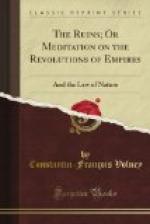“On the other hand, the astrological and geological priests told such stories and made such descriptions of their heavens, as accorded perfectly well with these fictions. Having, in their metaphorical language, called the equinoxes and solstices the gates of heaven, the entrance of the seasons, they explained these terrestrial phenomena by saying, that through the gate of horn (first the bull, afterwards the ram) and through the gate of Cancer, descended the vivifying fires which give life to vegetation in the spring, and the aqueous spirits which bring, at the solstice, the inundation of the Nile; that through the gate of ivory (Libra, formerly Sagittarius, or the bowman) and that of Capricorn, or the urn, the emanations or influences of the heavens returned to their source, and reascended to their origin; and the Milky Way, which passed through the gates of the solstices, seemed to be placed there to serve them as a road or vehicle.* Besides, in their atlas, the celestial scene presented a river (the Nile, designated by the windings of the hydra), a boat, (the ship Argo) and the dog Sirius, both relative to this river, whose inundation they foretold. These circumstances, added to the preceding, and still further explaining them, increased their probability, and to arrive at Tartarus or Elysium, souls were obliged to cross the rivers Styx and Acheron in the boat of the ferryman Charon, and to pass through the gates of horn or ivory, guarded by the dog Cerberus. Finally, these inventions were applied to a civil use, and thence received a further consistency.
See Macrob. Som. Scrip. c. 12.
“Having remarked that in their burning climate the putrefaction of dead bodies was a cause of pestilential diseases, the Egyptians, in many of their towns, had adopted the practice of burying their dead beyond the limits of the inhabited country, in the desert of the West. To go there, it was necessary to pass the channels of the river, and consequently to be received into a boat, and pay something to the ferryman, without which the body, deprived of sepulture, must have been the prey of wild beasts. This custom suggested to the civil and religious legislators the means of a powerful influence on manners; and, addressing uncultivated and ferocious men with the motives of filial piety and a reverence for the dead, they established, as a necessary condition, their undergoing a previous trial, which should decide whether the deceased merited to be admitted to the rank of the family in the black city. Such an idea accorded too well with all the others, not to be incorporated with them: the people soon adopted it; and hell had its Minos and its Rhadamanthus, with the wand, the bench, the ushers, and the urn, as in the earthly and civil state. It was then that God became a moral and political being, a lawgiver to men, and so much the more to be dreaded, as this supreme legislator, this final judge, was inaccessible and invisible. Then it was that




